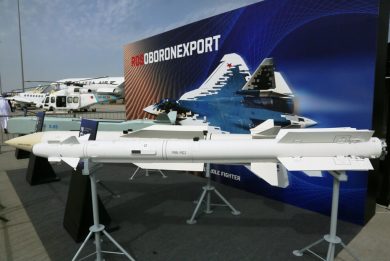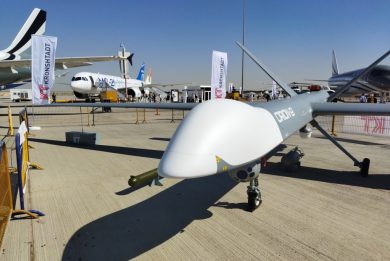
LIMA 2025 – Rosoboronexport provides new details on the Sukhoi Su-57, Russia’s new fifth-generation stealth fighter
At LIMA 2025 in Langkawi, Malaysia, Rosoboronexport exhibited in its booth a mock-up of the Sukhoi Su-57, NATO code ‘Felon’, the fifth-generation Russian fighter developed by Sukhoi to replace and complement previous-generation aircraft in the VKS (Vozdushno-kosmicheskiye sily, aerospace forces). This multi-role aircraft is designed for air superiority, ground attack, suppression of air defences, and in the near future will operate together with combat drones
The Su-57 has reduced radar signature, thanks to the use of composite materials, which represent around 25% of the structure, a radar-absorbing coating, and the integration of ordnance in the internal weapon bay. It is 19.8 metres long, has a 13.95 metres wingspan, and is 4.74 metres high. It has a maximum take-off mass of 34,000 kg and a maximum speed of around Mach 2 (2,470 to 2,950 km/h depending on the version). Its range is between 1,250 km (combat) and 4,000 km (ferry), and its ceiling is around 19,000 metres.
Thanks to a combination of swept wings, canard control surfaces, movable tail planes and thrust vectoring, the Su-57E is highly manoeuvrable and agile; it can reach angles of attack in excess of 60° and loads of up to 9 g. A fly-by-wire aircraft, the Su-57 maintains nonetheless mechanical back-up controls ensuring greater safety in the event of an electronic failure.

The aircraft is currently powered by two AL-41F1 (Izdeliye 117) advanced afterburner turbofans. These provide a dry thrust of over 86 kN, while when engaging the afterburner thrust goes up to over 142 kN. This engine represents a significant evolution from its predecessor, the AL-31F, which powered the Su-27 family of aircraft, the AL-41F providing a greater dry thrust of over 12%, and over 19% with afterburner, with a dry mass increase of only 4%. However, the modernised version, them Su-57M, will be powered by the new ‘Izdeliye 30’ engine (AL-51F), offering greater thrust both dry (>25%) and with afterburner (>17%) compared to the current AL-41F1, allowing improved efficiency, enhanced supercruise capability and increased maximum speed.
The Su-57 is equipped with an AESA X-band main radar, complemented by L-band side radars for the detection of stealth targets. It also features an advanced data fusion and an ‘intelligent skin’, a network of sensors integrated into the structure providing 360° situational awareness around the aircraft, as well as an integrated electronic warfare system, active decoys, directional jammer and infrared countermeasures. The pilot can rely on a head-up display and a helmet-mounted vision system; it also has a fully glass-cockpit with a single large-screen display. Thanks to the advanced avionics suite it the formation leader to assign targets to his aircraft.
The SU-57 is armed with air-to-air missiles (RVV-BD, RVV-SD, RVV-MD2 etc.), air-to-surface missiles (Kh-38MLE, Kh-58UShKE, Kh-69, Kh-35UE), guided bombs (KAB-250LG-E, UPAB-1500BE, K08BE), and is fitted with a GSh-30-1 30 mm cannon. The internal weapon bay can host up to 4 missiles in the main hold and 2 missiles in the side holds, 6 external pylons being available for additional armament.
The development of a new-generation fighter dates back to the late 1980s, but the programme was officially launched in 2002 when Sukhoi was selected. The development contract was signed in 2003, the prototype performing the maiden flight in January 2010. Several prototypes were built and tested, used intensively to verify performances, on-board systems and stealth. The programme was plagued by delays and technical problems, notably incidents during flight tests, including a fire on a prototype, and issues with the current engine which led to the decision to develop a new one, the Izdeliye 30.
The aircraft is currently in serial production with an order for 76 aircraft to equip three regiments of the Russian Aerospace Force. First operational deliveries took place in 2020, and the ramp-up is continuing.
The Su-57M modernised version will incorporate not only the new AL-51F engine, but also improved avionics, a modernised cockpit and increased automation (intelligent pilot assistance, voice or eye controls under development).
The Su-57 is the first non-US 5th generation fighter to have been tested in real combat situations, notably during the Russian military operation in Ukraine, where it carried out attack missions, suppression of air defences and, according to some sources, dogfight with enemy aircraft.
The Su-57 stands out for its super-manoeuvrability, its ability to operate from short runways, its versatility, being a multirole fighter-bomber aircraft, and maintenance cost that is claimed to be lower than that of its Western rivals.
The Su-57 continues to evolve, with the forthcoming arrival of the Su-57M version and the integration of advanced technologies (artificial intelligence, UAV control, intelligent cockpit). It is destined to become the cornerstone of the Russian combat aviation for decades to come, while it is also being offered for export in the Su-57E version.
Phtos by J. Roukoz



